Related sites:
Newsletter: Perspectives on Power Platform
Company: Niiranen Advisory Oy
The number of blogs, forums and news sites revolving around Microsoft Dynamics CRM can feel somewhat overwhelming, especially when you’ve spent some time being “unplugged” from the constant feed of information that surrounds our everyday lives. During my four week summer vacation I did managed to keep my hands off CRM most of the time, but the news and posts accumulating on my Google Reader still kept me quite firmly in the loop. Here’s a summary of a few Dynamics CRM related topics that caught my attention this summer.
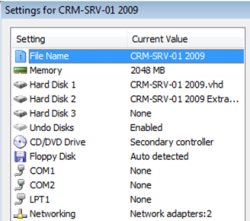 Microsoft released an updated version of the VPC image that comes with Dynamics CRM 4.0 preconfigured, available for download on CustomerSource or PartnerSource. There’s more on it than just CRM, check out the following list for all the goodies:
Microsoft released an updated version of the VPC image that comes with Dynamics CRM 4.0 preconfigured, available for download on CustomerSource or PartnerSource. There’s more on it than just CRM, check out the following list for all the goodies:
The image has been tweaked to include two virtual hard drives (VHD), allowing the swap file to be physically located on a USB drive, which is promised to improve performance by ~30%. How that figure has been determined is beyond me, but the environment works quite well on my Core i3 2.26GHz, 4GB, Win7 x64 setup. It would of course have been super nice to get your hands on a SharePoint 2010 environment, but the hassle of x64 environment virtualization with Hyper-V instead of Virtual PC would have not been worth all the trouble (although I’ve heard VirtualBox should be able to run also 64-bit images without Windows 2008 hosts). Let’s just settle for MOSS 2007 with Office 2010 client components.
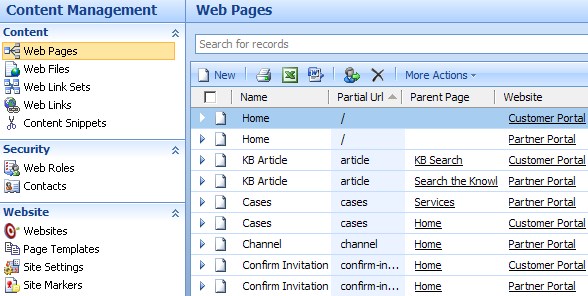
What made this VPC image especially interesting to me was the latest versions of the Portal Accelerators. Now, I never really had hands-on experience with the first wave of Portal Accelerators released for CRM 4.0, but from what I’ve heard the results delivered didn’t quite live up to people’s expectations. This new breed of accelerators, on the other hand, is based on the technology found in the commercial products of Adxstudio, who have built a full blown content management system on top of Dynamics CRM. I simply had to test drive the Customer Portal and Partner Relationship Management Portal, after seeing them promoted in Convergence 2010 Atlanta.
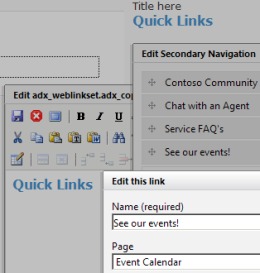 When accessing the portal side of the content, the sites offer you the kind of WYSIWYG editing controls you would expect to find in a modern CMS. Hover over content and you get the editing menu for in place editing of text, images and links. Any changes you peform on the content here will be stored to a record on the Web Page entity. Going into the CRM world and accessing the Content Management tab gives you a list of all the components that the portal site is made of. Effectively it’s the CMS database but presented with Dynamics CRM entities, lists and forms. You’ll find even site settings such as CSS attribute definitions as records on a grid, just like a customer contact would appear on your basic installation of Dynamics CRM.
When accessing the portal side of the content, the sites offer you the kind of WYSIWYG editing controls you would expect to find in a modern CMS. Hover over content and you get the editing menu for in place editing of text, images and links. Any changes you peform on the content here will be stored to a record on the Web Page entity. Going into the CRM world and accessing the Content Management tab gives you a list of all the components that the portal site is made of. Effectively it’s the CMS database but presented with Dynamics CRM entities, lists and forms. You’ll find even site settings such as CSS attribute definitions as records on a grid, just like a customer contact would appear on your basic installation of Dynamics CRM.
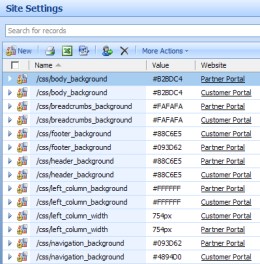 At first this might seem like a freaky way to build a website, but it really goes to show what the XRM concept can be like when taken to extremes. Just because Dynamics CRM as an off the shelf product is geared towards presenting sales managers a web page of accounts, opportunities, cases etc. doesn’t mean the platform couldn’t just as well deliver data on web page formating. Once you realise that all of the information on a website is being retrieved from the CRM database tables, it doesn’t take long for your imagination to start running wild when thinking about how the traditional customer related data could be pulled from the system and mashed up with web portal content. Typically any dynamic CRM attributes you need to present on a customer facing website means there’s lots of laborious integration planning and design sessions ahead before you get to see even the first rough demo. Building the CMS and CRM systems on top of the very same database flips things around and can certainly unlock ideas for designing portals that you might otherwise be hesitant to explore. Sure, plenty of development resources will still needed for implementing real solutions for production use, but the concept is quite impressive.
At first this might seem like a freaky way to build a website, but it really goes to show what the XRM concept can be like when taken to extremes. Just because Dynamics CRM as an off the shelf product is geared towards presenting sales managers a web page of accounts, opportunities, cases etc. doesn’t mean the platform couldn’t just as well deliver data on web page formating. Once you realise that all of the information on a website is being retrieved from the CRM database tables, it doesn’t take long for your imagination to start running wild when thinking about how the traditional customer related data could be pulled from the system and mashed up with web portal content. Typically any dynamic CRM attributes you need to present on a customer facing website means there’s lots of laborious integration planning and design sessions ahead before you get to see even the first rough demo. Building the CMS and CRM systems on top of the very same database flips things around and can certainly unlock ideas for designing portals that you might otherwise be hesitant to explore. Sure, plenty of development resources will still needed for implementing real solutions for production use, but the concept is quite impressive.
When considering building portals on top of CRM, it’s good to keep in mind the implications to license requirements. Presenting CRM data to external users and allowing them to interact with it will force you to buy an External Connector license from Microsoft for your on-premises environment. For a smaller organization that might otherwise find modifying the accelerator templates to their needs to be a sufficient solution, the cost of an EC license may well be prohibitive, which is really a shame considering the potential of the platform. However, CRM Online or partner hosted SPLA licensing models do not require External Connectors (see this post by Shan McArthur). So, not only is the cloud version of CRM much quicker to deploy than an on-premises IFD environment, the license pricing is becoming more and more favourable in the era of Social CRM, where the customer relationships data will increasingly be generated and collected somewhere out there in the clouds, beyond the corporate firewalls.
If Dynamics CRM can be used as a generic platform for rapid development of custom Line Of Business (LOB) applications or dynamic content portals like seen with the accelerators, then how should the product really be positioned in the market? Or even inside Microsoft’s own product portfolio? Comparisons between Dynamics CRM and SharePoint as application platforms has been discussed in many great white papers, one of my favourites being “Relational Productivity Applications: Leveraging Microsoft Dynamics CRM and SharePoint for Enhanced Business Impact“. But could there be even more alternatives to consider?
The recent beta launch of Visual Studio LightSwitch made me think about this topic some more, since so may of the selling points mentioned in Microsoft marketing material for LightSwitch ring a bell from the XRM gospel we’ve seen pushed for Dynamics CRM lately. LightSwitch is a SliverLight app development tool that’s being branded as the “simplest way to build business applications for the desktop, web and cloud”. “Quickly build custom LOB applications that rival off-the-shelf solutions.” “Simplifies the development process because it lets you concentrate on the business logic and does a lot of the remaining work for you.” “Designed for non-programmers, you don’t have to write any code for navigation, toolbars/ribbons, or dirty checking.” Yep, that’s CR… no, I mean LightSwitch. Check our this blog post from the product team for an introduction to the feature set included.
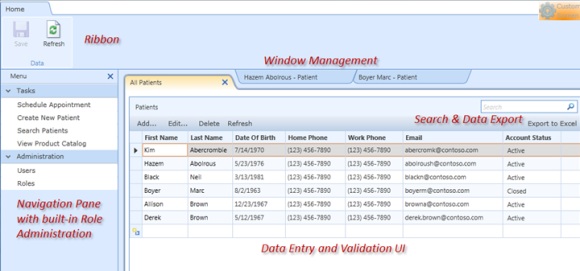
The conclusions behind the value proposition of LightSwitch do sound valid. Most mid-size organizations would surely benefit from being empowered to build their own LoB apps to replace overgrown Excel sheets, also most of these apps could share the same form, grid, search etc. concepts offered in familiar MS style UI wrappings. However, the approach is coming from the opposite direction than with Dynamics CRM. Whereas CRM has been first sold primarily as an application for business people to manage their customer data and later on expanded towards being an actual application development platform, LightSwitch is a component of the Visual Studio IDE used by programmers that now tries to reach the business users by promising no-code application development tools. You can already read plenty of furious “who is this sh** for?” type of comments from the VS user community, when MS is offering seemingly “dumbed down” development tools that aim to offer SilverLight app creation for the masses.
Since we already know that CRM 2011 will continue to have a traditional web application UI, not SilverLight, one question that comes to my mind is: will the two paths ever meet? In this era of “app internet” many are claiming that RIA clients are the future of web (which, according to credible sources, is already dead) and that there’s really no need to waith for HTML5 to come and save us. The bigger the ecosystem of existing customers, applications and services around the familiar Dynamics CRM becomes, the harded it can get to plan the platform’s evolution from “just” a web app to a rich internet application.
Could we somehow get the best of both worlds? One approach would be to use LightSwitch to build entity data driven forms to reach non-CRM users in the organization (as suggested by @CplCarrot), but this again brings up the licensing issues discussed earlier. While Dynamics CRM offers a far more advanced set of pre-built plumbing than LightSwitch, everything comes with a cost. If you’re an ISV and your solution would require the customer to purchase licenses for both CRM and your own application at the same time, the equation may well make you reconsider if all that plumbing is necessary after all.
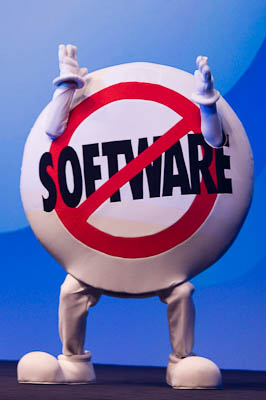 I really enjoyed reading Behind The Cloud, in which Marc Benioff tells the story behind Salesforce.com. No matter what you think about their product in terms of CRM, you have to give credit to the company that has been such a major force (sic) behind launching the SaaS movement into the massive cloud hype that we see everywhere around us today. Challenging the traditional “Enterprise 1.0” giants like SAP and Orcale (Marc’s previous employer) in the race for the next generation of business applications has earned Salesforce.com the status that is now making tech media around the world consider Microsoft as the underdog in the game of CRM. Just like SFDC in its early days gained big boost from ceaselessly attacking it’s nr. 1 enemy Siebel, I’m positive this head-to-head battle will only do good for Dynamics CRM in the long run.
I really enjoyed reading Behind The Cloud, in which Marc Benioff tells the story behind Salesforce.com. No matter what you think about their product in terms of CRM, you have to give credit to the company that has been such a major force (sic) behind launching the SaaS movement into the massive cloud hype that we see everywhere around us today. Challenging the traditional “Enterprise 1.0” giants like SAP and Orcale (Marc’s previous employer) in the race for the next generation of business applications has earned Salesforce.com the status that is now making tech media around the world consider Microsoft as the underdog in the game of CRM. Just like SFDC in its early days gained big boost from ceaselessly attacking it’s nr. 1 enemy Siebel, I’m positive this head-to-head battle will only do good for Dynamics CRM in the long run.
Richard Knudson wrote a spot on article about the competitive setting between MSFT and SFDC. The announcement of Dynamics CRM 2011 has drawn a wealth of attention on the subject, now that Microsoft is finally promising a near-identical CRM feature set for both on-premises and cloud hosted deployment models. Looking at the signs out there, I’m inclined to believe in Richard’s prediction that “over the next couple years, the CRM market will be a two-horse race”.
The AppExchange marketplace is certainly something Microsoft will have a tough time replicating overnight, so I’m expecting the introduction of the Dynamics Marketplace to be just the first iteration of a long project in developing a solution that truly bridges the gap between the SMB customers and the vast but fragmented ISV ecosystem. And while Chatter may not be a revolutionary application when compared to the front line collaborative solutions out there (more like “lipstick on a pig“?), it’s still offering a solution that Microsoft doesn’t have a direct answer to in CRM 2011.
One big reasons why you shouldn’t underestimate Microsoft’s chances in the CRM horse race is because, well, this is exactly what Microsoft does. Looking at the company’s history, it never is the first player on the new market, or the most technically advanced application of the day, yet it tends to roll onwards like I giant freight train. Slow to get on the way, but almost unstoppable once the wheels are in motion. You could blame it on just an endless marketing budget, but that would be depreciating MSFT’s incredible business hunch and the track record it has for striking when and where the competition is at its weakest. At the end of the day, so many of Microsoft’s customers are also freight trains. That’s corporate IT and it doesn’t like changes that take place overnight, unlike what we as individuals in the corporate IT world might think about the pace of change.
Of course even Microsoft itself is now proclaiming that the end is near for traditional server deployments and that the clouds with silver lining are already upon us. Coming from the mouth of Steve Ballmer, you could think that such a message would totally play in the hands of Marc Benioff, but I wouldn’t be so sure. Call me a sucker for Microsoft’s marketing propaganda if you will, I still think the company is building it’s Azure offering and cloud momentum with exactly the right steps to challenge the early SaaS pioneers with a next level architecture that goes beyond the initial “hey, let’s outsource servers and save some $$$” thinking. Ok, that may be a gross exaggeration, but what I’m saying is that coming to the party late gives you more time to select the dress and finalize the make-up. And Microsoft is always late.
As long as most new cloud app users are coming from the MS Office world, Microsoft will likely continue to have an upper hand in the Outlook client development (read an example of SFDC’s Outlook 2010 woes). No matter how data driven the CRM applications become through the real time feeds of social network alerts and what have you, there will always be an office worker physically using the application. He or she will want to print documents from the data, pull it into Excel and synchronize it with the address book. Unless Microsoft loses the battle for the office market to Google Apps and Android, there’s bound to be a strong selling point there for Dynamics CRM for many years to come.
When you spend most of your days working within a particular instance of CRM for a specific industry, it’s always refreshing to get a look at what someone else has built from the same ingredients. Lauren Carlson from Software Advice sent me a link to her review of 15 industry specific vertical solutions built on top of Dynamics CRM by Microsoft Partners. This is a great snapshot of what the market out there looks like in terms of packaged CRM/XRM offerings. I urge you to click through to some of the vendors’ sites and explore the ways how CRM is being sold to markets that are likely to be totally unfamiliar to you.

Although I’m sure these partners have invested a great deal of time and their industry expertise in packaging these solutions, the question that comes to my mind is “does this particular one size fit all”? Building a vertical solution must be an effective way to get your foot in the door and talk to the potential customers, but with the exceptional customizability of Dynamics CRM, how many customers will end up deploying only the contents of the standard package and not twist it to their specific needs and business practices? Probably not so many, which of course isn’t a bad thing by any means. It just means that out of any predefined selection of solutions, there will be an huge number of permutations that people will call “our CRM”.
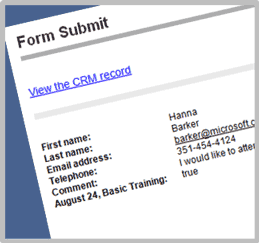 One of the applications we have lately spent time deploying and training in our organization is the CoreMotives Marketing Suite. While we initially were searching for merely a tool to replace our previous email marketing system integration that couldn’t scale to meet our growing CRM userbase’s requirements, what we ended up buying with CoreMotives goes far beyond just email blasts and click-rate tracking. The real selling point is in being able to start tracking website visitors already when they are still anonymous to your business, then later on convert them into identified leads with a page view history that the sales person can use for profiling the lead. To get an idea of what possibilities the CoreMotives tracking scripts open up, have a look at this piece of news regarding their latest enhancements to web form data capture to CRM.
One of the applications we have lately spent time deploying and training in our organization is the CoreMotives Marketing Suite. While we initially were searching for merely a tool to replace our previous email marketing system integration that couldn’t scale to meet our growing CRM userbase’s requirements, what we ended up buying with CoreMotives goes far beyond just email blasts and click-rate tracking. The real selling point is in being able to start tracking website visitors already when they are still anonymous to your business, then later on convert them into identified leads with a page view history that the sales person can use for profiling the lead. To get an idea of what possibilities the CoreMotives tracking scripts open up, have a look at this piece of news regarding their latest enhancements to web form data capture to CRM.
Capturing more data is not an automatic road to success, so having the tracking capabilities of CoreMotives Web Intelligence at your disposal will definitely require also your online marketing process to be well thought out, with clear conversion targets in your mind. Nevertheless, the typical response from any marketing person that has been shown what you could do with the tools has been along the lines of “holy sh**, this is awesome!”, which leads me to believe that the investments needed on the process development side will probably also surface.
The CoreMotives solution is built on Windows Azure as one of the first Dynamics CRM applications on that infrastructure. You might want to glance through this Microsoft case study (where I also contributed a few words) that takes a look at what the new cloud service models mean for start-up ISV’s like CoreMotives that want to rapidly expand to international markets.
Another application that has caught my eye during the summer has been the M-Files for Microsoft Dynamics CRM. Developed by Motive Systems Oy, this document management system integration is a welcome addition to the relatively new market of Dynamics CRM add-ons developed and productized by Finnish companies.
Some more add-on products are also being actively promoted in Finland during this fall on the CRM Festival 2010, a joint roadshow from Anvia (the company behind the hosted service CRMpalvelu.fi) and a selection of partners like Snoobi and BookIT. Multiple sources have told me the registrations for these events have already been a great success, which gives an indication that the interest towards Dynamics CRM in our local market is steadily growing.
Let’s face it, Dynamics CRM is not a particularly fast web application when used over a WAN connection with high latency due to physical distance from the client to the server. This is a common scenario for companies who need to operate on global markets with regional offices, some of which may struggle to find a reliable internet connection provider to begin with in their local market. Application response times are a critical factor in driving the adoption of systems like CRM, so paying attention to the service level of your application server and the underlying infrastructure is a must.
Did you know that you can reduce the number of HTTP requests from the CRM client to the application server to almost half by removing unnecessary authentication settings from static content? The solution we have adopted so far has been to disable NTLM authentication from images and scripts by manually going through the various folders on the CRM website. No need for that anymore! As discovered by Dave Berry, there is in fact a registry key setting that will make IIS remember the Kerberos authentication after the initial HTTP request. Read KB917557 for more details on how to set this up on your Dynamics CRM application server.
Ok, I’m sure most of you know by now that CRM 5 is CRM 2011 and the RTW of CRM Online is promised to take place before the end of the year, as announced in WPC 2010. The beta version is arriving already this month and that will surely cause an information explosion in the CRM blogosphere. Having had the privilege of using the CTP3 version of CRM 2011 Online as a part of the Microsoft Early Adopter Program our company is participating in, I can only say “it’s worth the wait”. Once the NDA is lifted, hopefully I will have the chance to share many more thoughts about the upcoming version and how we’re planning to utilize it. Stay tuned for updates.
